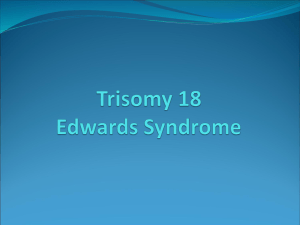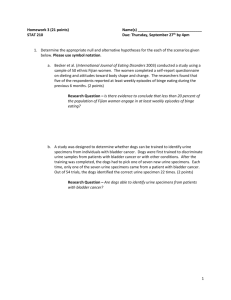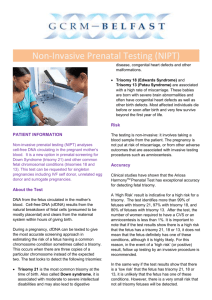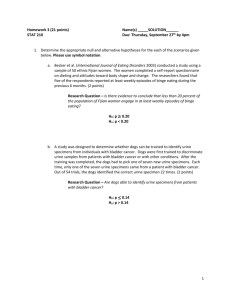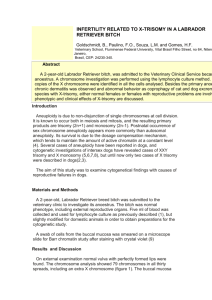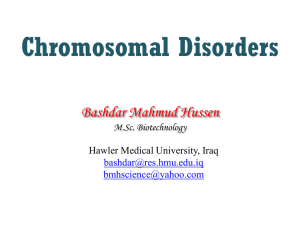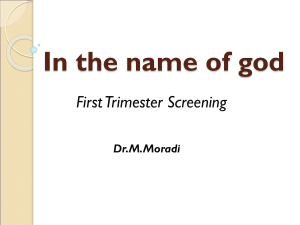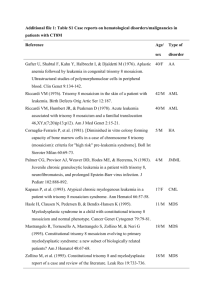Trisomy 21 - e
advertisement
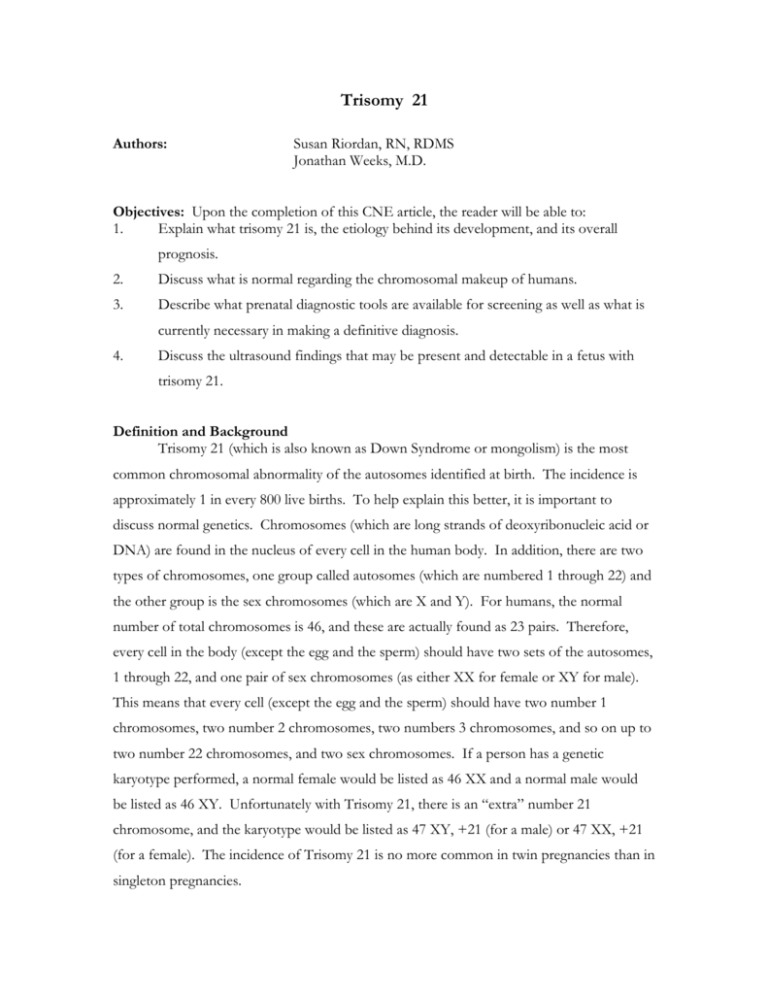
Trisomy 21 Authors: Susan Riordan, RN, RDMS Jonathan Weeks, M.D. Objectives: Upon the completion of this CNE article, the reader will be able to: 1. Explain what trisomy 21 is, the etiology behind its development, and its overall prognosis. 2. Discuss what is normal regarding the chromosomal makeup of humans. 3. Describe what prenatal diagnostic tools are available for screening as well as what is currently necessary in making a definitive diagnosis. 4. Discuss the ultrasound findings that may be present and detectable in a fetus with trisomy 21. Definition and Background Trisomy 21 (which is also known as Down Syndrome or mongolism) is the most common chromosomal abnormality of the autosomes identified at birth. The incidence is approximately 1 in every 800 live births. To help explain this better, it is important to discuss normal genetics. Chromosomes (which are long strands of deoxyribonucleic acid or DNA) are found in the nucleus of every cell in the human body. In addition, there are two types of chromosomes, one group called autosomes (which are numbered 1 through 22) and the other group is the sex chromosomes (which are X and Y). For humans, the normal number of total chromosomes is 46, and these are actually found as 23 pairs. Therefore, every cell in the body (except the egg and the sperm) should have two sets of the autosomes, 1 through 22, and one pair of sex chromosomes (as either XX for female or XY for male). This means that every cell (except the egg and the sperm) should have two number 1 chromosomes, two number 2 chromosomes, two numbers 3 chromosomes, and so on up to two number 22 chromosomes, and two sex chromosomes. If a person has a genetic karyotype performed, a normal female would be listed as 46 XX and a normal male would be listed as 46 XY. Unfortunately with Trisomy 21, there is an “extra” number 21 chromosome, and the karyotype would be listed as 47 XY, +21 (for a male) or 47 XX, +21 (for a female). The incidence of Trisomy 21 is no more common in twin pregnancies than in singleton pregnancies. Etiology Trisomy 21, as stated above, is a genetic disorder caused by the presence of an extra number 21 chromosome. Approximately 95% of these occur during meiosis because of nondisjunction (which is a failure of the chromosomes to separate during metaphase). The extra chromosome 21 has a maternal origin in 80% of cases and a paternal origin in 20% of cases. Maternal age is most strongly correlated with the prevalence of nondisjunction, and the risk increases as the mother’s age increases. For example the risk of trisomy 21 in a mother who is 20 at the time of delivery is about 1 in 1900, increasing to a risk of about 1 in 900 by the age of 30, increasing to a risk of about 1 in 100 for a mother who is 40 at the time of delivery. Prenatal Diagnosis – Diagnostic Testing Maternal age is weighted the most heavily in relationship to the incidence of trisomy 21. It is well known that increasing maternal age increases the risk of most chromosomal abnormalities. Prenatal diagnosis can involve several diagnostic tools one of which is a blood test known as a maternal serum alpha-fetoprotein (MSAFP). The premise of this test is the association between lower blood levels of AFP in the mother who is carrying a pregnancy with certain chromosomal abnormalities, especially trisomy 21. The decreased maternal blood level of AFP may be explained by a lower production of alpha-fetoprotein by the fetal liver (and this lower production of AFP by the trisomy 21 fetus results in less transfer into the mother’s circulation). The MSAFP blood test can be drawn between 15 and 20 weeks gestational age and can be used to determine if the mother has an increased risk for having a trisomy 21 fetus, and if positive, the test would usually be reported as a “low MSAFP” value. If the MSAFP is the only test performed, it will identify about 25% of the pregnancies that are carrying a trisomy 21 fetus. Other serum markers that may be used for predicting an increased risk for trisomy 21 have been identified over the years. One of these is unconjugated estriol, which is also found to have a lower blood level in mother’s carrying a trisomy 21 fetus, presumably due to a lower production by the fetal liver (just like AFP). Another serum marker is human chorionic gonadotropin (HCG), which is found to be higher in the blood stream of mother’s who are carrying a trisomy 21 fetus. Using this knowledge regarding AFP, unconjugated estriol, and HCG, a second prenatal diagnostic blood test was developed called a “triple marker screen”. By combining the results of these three serum markers along with the mother’s age, her weight, and race, a new risk can be created that can allow the pregnant couple the opportunity to determine if they wish to seek further testing. This triple marker screen can identify up to 60% of the pregnancies that are carrying a trisomy 21 fetus. To truly rule in or out whether or not a mother is carrying a trisomy 21 fetus currently requires an invasive test that unfortunately carries a small risk of losing the pregnancy. Therefore, pregnant couples have to determine if they want to take this risk in order to completely know one way or another. The two currently available definitive tests (which are invasive) are the genetic amniocentesis and chorionic villus sampling or CVS. It should be noted that 80% of fetuses with trisomy 21 are born to women who are younger than 35 years of age and who are not routinely offered invasive testing. It is also interesting to note that approximately three-fourths of Trisomy 21 fetuses spontaneously abort – the majority of which occur during the first trimester. Despite the fact that up to 60% of pregnancies with trisomy 21 may be identified utilizing the triple marker screening test (verified by an invasive test), a significant number of cases are still missed. This brings in the potential value of the ultrasound examination. Ultrasound Findings Individuals with trisomy 21 may display a wide range of birth defects, which include a typical facie, low-set ears, a protruding tongue, a broad nasal bridge, poor tone, a single palmar crease (simian crease), a single flexion crease in the fifth digit, and a wide space between the first and second toe. Common internal anomalies include cardiac defects (often an endocardial cushion defect) and duodenal atresia. Essentially all individuals with trisomy 21 who survive beyond infancy will have some degree of mental retardation (ranging from mild to severe). Many of the anomalies associated with trisomy 21 cannot be accurately identified by ultrasound. However, with improved technology and the use of transvaginal ultrasound scanning, the ability to detect trisomy 21 has increased. The majority of anomalies that may be seen cannot be identified in the first trimester. The ultrasound findings that may indicate the presence of trisomy 21 when found in the early second trimester include the following: Thick nuchal fold – this has become one of the more commonly performed ultrasound evaluations for identifying trisomy 21 and by reports is present in 40% to 70% of cases. The nuchal fold is seen when a modified transverse view of the fetal head is used, which includes the cerebellum and occipital bone. The fold is measured from the outer edge of the occipital bone to the outer edge of the fetal scalp. This finding is significant between 15 and 20 weeks gestation when it measures 6 mm or greater (figure 1). Renal pelvis dilatation – up to 25% of trisomy fetuses can have pylectasis defined by most as greater than 4 mm in the anteroposterior (AP) dimension between 15 and 20 weeks gestation. Cardiac defects – the most common defect is an atrioventricular canal defect (or endocardial cushion defect) (figure 2), other cardiac anomalies may include a ventricular septal defect or VSD (which can easily be missed if the defect is small, especially when scanning prior to 20 weeks gestation) and Tetralogy of Fallot. Duodenal atresia / stenosis – this defect, if present, is not usually detected until after 24 weeks gestation. A “double-bubble” will be seen on ultrasound along with polyhydramnios (figure 3). Up to 30% of fetuses with duodenal atresia will have trisomy 21; whereas conversely, only 15% of trisomy fetuses will have duodenal atresia. Hyperechogenic bowel – a fairly uncommon finding, but by definition, its echogenicity should be similar to that of bone (figure 4). Hypoplasia of the middle phalanx of the fifth digit with an inward curvature of the finger A bright papillary muscle also known as an “echogenic intracardiac focus” most commonly seen in the left ventricle of the fetal heart (figure 5). Sandalfoot – a wide space between the big toe and the second toe (figure 6). Shortened femur and humerus – these long bones are often shorter in fetuses with trisomy 21 when compared to controls. Several authors have created cutoff values for the ratio of the biparietal diameter to femur length (BPD/FL ratio); however, these tables vary somewhat between institutions. Brachycephaly – the cephalic index is the ratio of the width of the skull (at the level of the BPD) to the length of the skull (or AP dimension). If this index is greater than 83%, then the head is considered to be brachiocephalic (or more round in shape). Fetuses with trisomy 21 often have a brachiocephalic head, but this may not be appreciated until the third trimester (and many brachiocephalic heads are normal variations). If the cephalic index is less than 74%, this is called dolichocephaly (or a head that is narrow or more oval in shape). One finding that may be useful in first trimester scanning is nuchal lucency. If a nuchal lucency of 3 mm or greater is identified in the first trimester between 10 and 14 weeks gestation, this can lead to the detection of as many as one third of trisomy fetuses. It should still be emphasized that only about 50% of fetuses with trisomy 21 will have a recognizable ultrasound abnormality. The MSAFP blood test, the triple marker blood test, and ultrasound findings are still screening tests and cannot tell the patient (for sure) that they are carrying a trisomy 21 fetus. Many false positive and false negative evaluations will occur. The only definitive way, currently, to tell a patient (or couple) that the fetus indeed does have the genetic abnormality is to perform an invasive procedure such as an amniocentesis or chorionic villus sampling, which unfortunately does carry a small but not insignificant risk of losing the pregnancy. These situations are always stressful for pregnant couples and they produce many difficult ethical and moral decisions. However, the final decision on how to proceed should come from the couple. Prognosis When a definitive diagnosis for trisomy 21 is made prior to 23 to 24 weeks gestation, another set of difficult decisions develop regarding the continuation of the pregnancy versus pregnancy termination. Again, this is a personal choice for the parents (often involving moral, ethical, and religious beliefs), and they should be given as much information as possible to help them in their decision making process. During the first year of life, health services are nearly double for the trisomy 21 infant. Approximately 15% to 20% will die in the first year of life from congestive heart failure or leukemia. Infants are usually hypotonic at birth, and males are usually infertile. Recurrent upper respiratory tract infections are common. As stated before, there are various degrees of mental retardation (ranging from mild to severe), but this cannot be determined through genetic testing. If a couple is found to have a trisomy 21 fetus (unrelated to a chromosomal translocation), the recurrence risk for future pregnancies is approximately 1%. Therefore, these couples should be referred to genetic counseling with any future pregnancies. Figures 1 A measurement of 8 mm for the nuchal thickness at 18 weeks gestation in a fetus with trisomy 21. 2 Endocardial cushion defect – the interventricular septum, the interatrial septum, and the mitral and tricuspid valves produce a “cross” appearance within the heart at the level of the 4-chamber view. Note that the center portion of this cross is absent. 3 A “double-bubble” identified in a 30-week fetus (the infant did not have trisomy 21). 4 Hyperechogenic bowel – note that its echogenicity is similar to that of bone. 5 An “echogenic focus” of the papillary muscle seen in the left ventricle of the fetal heart. This fetus did not have trisomy 21. 6 An example of a “sandalfoot” with a wide space between the big toe and the second toe. This was seen in the trisomy 21 fetus mentioned in figure number 1. References and Suggested Reading 1. Fleischer A, Manning F, Philippe J, Romero R. Sonography in Obstetrics and Gynecology. 1996 pp 494-499. 2. Harrison M, Golbus M, Filly R. The Unborn Patient. 1990 pp 64-65. 3. Chervenak F, Isaacson G, Campbell S. Ultrasound in Obstetrics and Gynecology. Volume 2 1993 pp 1123-1126, 1135, 1145-49. 4. Callen P. Ultrasonography in Obstetrics and Gynecology. 1994 pp 35, 37-42, 399. 5. Benacerraf B. Ultrasound of Fetal Syndromes. 1998 pp 328, 331-336, 414-415. 6. Reece A, Hobbins J, Mahoney M, Petrie R. Medicine of the Fetus and Mother. 1992 pp 399, 475, 617, 665, 1355. 7. Fleischer A, Romero R, Manning F, Jeanty P, James E. Ultrasonography in Obstetrics and Gynecology. 1991 pp 268-69, 307-312. 8. Creasy R, Resnick R. Maternal-Fetal Medicine. 1994 pp 24-26, 35. 9. Gabbe S, Niebyl J, Simpson J. Obstetrics: Normal and Problem Pregnancies. 1996 pp 55, 216-18, 225-26. 10. Romero R, Pilu G, Jeanty P, Ghidini A, Hobbins J. Prenatal Diagnosis of Congenital Anomalies. 1988 pp 196-97, 206, 215, 237. 11. Benacerraf BR, Gelman r, Frigoletto FD. Sonographic identification of secondtrimester fetuses with Down’s syndrome. N Engl J Med 1987;317:1371-6. 12. Hill LM, Guzick D, Belfar H, et al. The current role of sonography in the detection of Down syndrome. Am J Obstet Gynecol 1989;74:620-3. 13. Nyberg DA, Resta RG, Luthy DA, et al. Prenatal sonographic findings of Down’s syndrome: review of 94 cases. Obstet Gynecol 1990;76:370-7. 14. Benacerraf BR, Frigoletto FD. Soft tissue nuchal-fold in the second trimester fetus: standards for normal measurements compared with those in Down syndrome. Am J Obstet Gynecol 1987;157:1146-9. About the Authors Susan Riordan received her Bachelors degree in nursing in 1979 and has been a full time nurse for 21 years. She has worked in labor and delivery, postpartum, and the newborn nursery. She has been a high-risk obstetrical sonographer for the past 10 years and received her RDMS in Obstetrics and Gynecology in 1997. She currently works at Norton Suburban Hospital in Maternal-Fetal Medicine under the direction of Dr. Jonathan Weeks. Jonathan Weeks, M.D. is a board certified Obstetrician / Gynecologist and Perinatologist. He is currently director of the Maternal Fetal Medicine Center at Norton Suburban Hospital. Dr. Weeks has several publications in peer-review medical journals and has lectured at numerous meetings across the country. Examination: 1. For humans, the normal number of total chromosomes is A. 46 B. 23 C. 22 D. 47 E. 44 2. The karyotype for a male with trisomy 21 would be A. 46 XX, +21 B. 46 XY, +21 C. 47 XX, +21 D. 47 XY, +21 E. 23 XY, +21 3. Approximately 95% of trisomy 21 cases occur during meiosis because A. of nondisjunction B. the mother carries it as a translocation C. the father carries it as a translocation D. of a translocation (mother or father) E. of disorganization 4. The extra chromosome 21 has a maternal origin in _______ of cases. A. 20% B. 40% C. 60% D. 80% E. 95% 5. Regarding the maternal serum alpha-fetoprotein (MSAFP) test, the premise of this test is the association between _________ who is carrying a pregnancy with certain chromosomal abnormalities, especially trisomy 21. A. higher blood levels of AFP in the mother B. lower blood levels of AFP in the mother C. higher blood levels of AFP in the fetus D. higher blood levels of AFP in the amniotic fluid E. lower levels of AFP in the mother’ liver 6. If the MSAFP is the only test performed, it will identify about _________ of the pregnancies that are carrying a trisomy 21 fetus. A. 95% B. 50% C. 75% D. 10% E. 25% 7. Regarding other serum markers that may be used for predicting an increased risk for trisomy 21, which of the following statements is true? A. Maternal unconjugated estriol levels and human chorionic gonadotropin (HCG) levels are often higher in the blood stream of mother’s who are carrying a trisomy 21 fetus. B. Maternal unconjugated estriol levels and human chorionic gonadotropin (HCG) levels are often lower in the blood stream of mother’s who are carrying a trisomy 21 fetus. C. Maternal unconjugated estriol levels are often lower, whereas human chorionic gonadotropin (HCG) levels are often higher in the blood stream of mother’s who are carrying a trisomy 21 fetus. D. Maternal unconjugated estriol levels are often higher, whereas human chorionic gonadotropin (HCG) levels are often lower in the blood stream of mother’s who are carrying a trisomy 21 fetus. E. Maternal unconjugated estriol levels are often higher, and human chorionic gonadotropin (HCG) levels are often lower in the blood stream of the trisomy 21 fetus when compared to the mother. 8. The triple marker screen (of MSAFP, unconjugated estriol, and HCG) can identify up to ________ of the pregnancies that are carrying a trisomy 21 fetus. A. 95% B. 80% C. 60% D. 40% E. 25% 9. The two currently available definitive tests (which are invasive) are A. the MSAFP test and chorionic villus sampling B. the MSAFP test and the genetic amniocentesis C. the triple marker screen and the MSAFP test D. the triple marker screen and chorionic villus sampling E. the genetic amniocentesis and chorionic villus sampling 10. It should be noted that ________ of fetuses with trisomy 21 are born to women who are younger than 35 years of age and who are not routinely offered invasive testing. A. 95% B. 80% C. 60% D. 40% E. 25% 11. Approximately __________ of Trisomy 21 fetuses spontaneously abort – the majority of which occur during the first trimester. A. three-fourths B. four-fifths C. two-thirds D. one-half E. one-third 12. Individuals with trisomy 21 may display a wide range of birth defects, which include all of the following except A. a protruding tongue B. an endocardial cushion defect C. a broad nasal bridge D. a wide space between the fourth and fifth toe E. duodenal atresia 13. Regarding nuchal fold thickness, this finding is significant between 15 and 20 weeks gestation when it measures A. 3 mm or greater B. 4 mm or greater C. D. E. 5 mm or greater 6 mm or greater 7 mm or greater 14. Renal pelvis dilatation can be seen in up to 25% of trisomy fetuses, and it is defined by most as _____________ between 15 and 20 weeks gestation. A. greater than 6 mm in the anteroposterior (AP) dimension B. greater than 6 mm in the longitudinal dimension C. greater than 4 mm in the anteroposterior (AP) dimension D. greater than 4 mm in the longitudinal dimension E. greater than 1 cm in the longitudinal dimension 15. Regarding duodenal atresia / stenosis, which of the following statements is true? A. If present, it is usually detected prior to 24 weeks gestation. B. May produce polyhydramnios, but not in the presence of a “double-bubble” sign. C. If present, it will primarily only occur in conjunction with an endocardial cushion defect. D. Up to 80% of fetuses with duodenal atresia will have trisomy 21. E. Only 15% of trisomy fetuses will have duodenal atresia. 16. A fetus with trisomy 21 may display all of the following except A. Hypoplasia of the middle phalanx of the fifth digit with an inward curvature of the finger B. Hypoechogenic bowel C. an “echogenic intracardiac focus” most commonly seen in the left ventricle of the fetal heart D. Shortened femur and humerus when compared to controls E. Sandalfoot appearance 17. The cephalic index is the ratio of the width of the skull (at the level of the BPD) to the length of the skull (or AP dimension). If this index is ________ then the head is considered to be brachiocephalic. A. less than 83% B. greater than 83% C. less than 74% D. greater than 74% E. greater than 88% 18. If a nuchal lucency of __________ is identified in the first trimester between 10 and 14 weeks gestation, this can lead to the detection of as many as one third of trisomy fetuses. A. 3 mm or greater B. 4 mm or greater C. 5 mm or greater D. 6 mm or greater E. 7 mm or greater 19. Approximately ________ will die in the first year of life from congestive heart failure or leukemia. A. 75% to 80% B. 60% to 75% C. 50% to 60% D. 35% to 50% E. 15% to 20% 20. If a couple is found to have a trisomy 21 fetus (unrelated to a chromosomal translocation), the recurrence risk for future pregnancies is approximately A. 10%. B. 8% C. 1% D. 15% E. 25%

